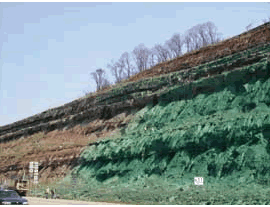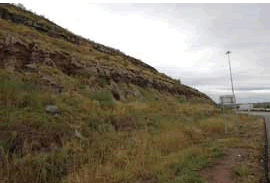West Virginia Highway 47 Cut
"In 15 years of working with hydraulic products, I’ve never encountered a more challenging project," says Stephen Zwilling of Profile Products LLC in Buffalo Grove, IL. He’s referring to the 14-acre Highway 47 cut revegetation project in Parkersburg, WV.
"There have been many attempts over a number of years to establish vegetation here,” he explains. “When the highway was originally built and the mountainside cut, there wasn’t the erosion now found at the site."
The problem is that this piece of mountain adjacent to the highway is very steep and very high, reaching as high as 425 feet above the pavement. In the past, the state department of transportation (DOT) had tried various options, including broadcast seeding and hydroseeding. They had considered the use of erosion control blankets, but with nearly vertical, highly eroded slopes, it was unlikely that blankets could even be installed. Building a large concrete retaining wall was another option, but its multi-million-dollar price tag effectively ruled out this hard-armor solution.
"None of the previous attempts grew anything significant," Zwilling says. "Eventually, regulatory agencies got involved and put pressure on the highway department to do something." There was concern about potential rockslides, as well as concern for the water quality of nearby creeks.
Marc S. Theisen, vice president of Erosion Control Solutions with Profile Products, explains that his firm was brought in to try to resolve the ongoing issues. He found not only that the mountainside was eroding and “very inhospitable to revegetation,” but also that access to the site was very challenging; so much so, in fact, that the state had considered the use of a helicopter in its hydroseeding efforts. Theisen explains that the overall slope of the hillside was greater than a 45-degree angle, measuring about 0.75 horizontal to 1 vertical, with certain sections even steeper.
Yet another problem popped up. Theisen and Zwilling both note that the soil in this part of the country, as in much of the eastern US, tends to be somewhat acidic, and officials at the West Virginia DOT naturally assumed that this Highway 47 cut was no exception. However, no soil sampling had been done.
"You’d be surprised," Theisen says, "how often such projects proceed without any agronomic soil testing. They’ll do all the geotechnical and sieve analysis tests to keep the engineers happy, but they often fail to conduct any agronomic testing."
West Virginia Highway 47 Cut ~ Soil Analysis
Ultimately, a soil analysis was conducted, which set off several alarms. Most shocking was the pH of the soil. Rather than being slightly acidic, the soil pH measured as high as 10, which is highly alkaline. Zwilling notes that the department had planned on adding lime-based soil amendments, thinking that perhaps the presumed acidity of the soil was contributing to the difficulty in obtaining viable vegetation.
Zwilling is not surprised that a soil sample had not previously been taken. He speaks to and works with engineering firms routinely and finds that perhaps 95% of the time, a soil test is not conducted prior to breaking ground. "But these are very inexpensive," he says, "costing perhaps $50 or less, rising to around $200 if immediate or more extensive analyses are needed. When I tell them the low cost of soil tests, and note that pH is the second-most-critical consideration (after water) for ensuring effective nutrient uptake and successful establishment of vegetation, I find that they are appreciative, and many people are changing their ways. For example, both the West Virginia DOT and the South Carolina DOT now require that soil be tested"


Zwilling emphasizes, "When plants are trying to establish themselves, everything needs to be in balance so immature plants can establish their root systems and grow." And the pH level is an important part of the equation. Ideally, soil pH should fall within a range of 6.3 to 7.3 for healthy plant growth.
Leave a Reply
You must be logged in to post a comment.